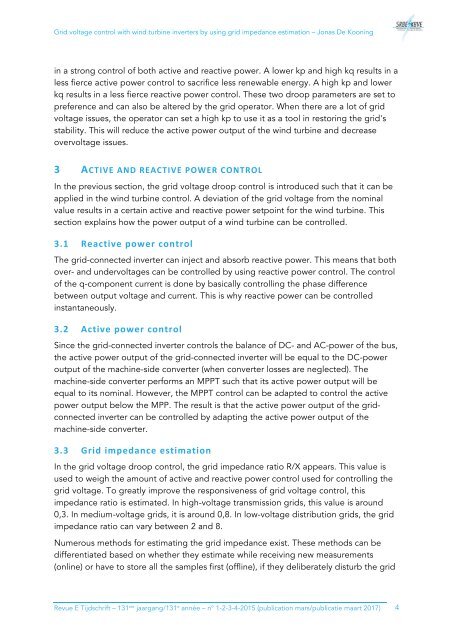RET_2015-01-02-03-04_Flipbook
You also want an ePaper? Increase the reach of your titles
YUMPU automatically turns print PDFs into web optimized ePapers that Google loves.
Grid voltage control with wind turbine inverters by using grid impedance estimation – Jonas De Kooning<br />
in a strong control of both active and reactive power. A lower kp and high kq results in a<br />
less fierce active power control to sacrifice less renewable energy. A high kp and lower<br />
kq results in a less fierce reactive power control. These two droop parameters are set to<br />
preference and can also be altered by the grid operator. When there are a lot of grid<br />
voltage issues, the operator can set a high kp to use it as a tool in restoring the grid's<br />
stability. This will reduce the active power output of the wind turbine and decrease<br />
overvoltage issues.<br />
3 ACTIVE AND REACTIVE POWER CONTROL<br />
In the previous section, the grid voltage droop control is introduced such that it can be<br />
applied in the wind turbine control. A deviation of the grid voltage from the nominal<br />
value results in a certain active and reactive power setpoint for the wind turbine. This<br />
section explains how the power output of a wind turbine can be controlled.<br />
3.1 Reactive power control<br />
The grid-connected inverter can inject and absorb reactive power. This means that both<br />
over- and undervoltages can be controlled by using reactive power control. The control<br />
of the q-component current is done by basically controlling the phase difference<br />
between output voltage and current. This is why reactive power can be controlled<br />
instantaneously.<br />
3.2 Active power control<br />
Since the grid-connected inverter controls the balance of DC- and AC-power of the bus,<br />
the active power output of the grid-connected inverter will be equal to the DC-power<br />
output of the machine-side converter (when converter losses are neglected). The<br />
machine-side converter performs an MPPT such that its active power output will be<br />
equal to its nominal. However, the MPPT control can be adapted to control the active<br />
power output below the MPP. The result is that the active power output of the gridconnected<br />
inverter can be controlled by adapting the active power output of the<br />
machine-side converter.<br />
3.3 Grid impedance estimation<br />
In the grid voltage droop control, the grid impedance ratio R/X appears. This value is<br />
used to weigh the amount of active and reactive power control used for controlling the<br />
grid voltage. To greatly improve the responsiveness of grid voltage control, this<br />
impedance ratio is estimated. In high-voltage transmission grids, this value is around<br />
0,3. In medium-voltage grids, it is around 0,8. In low-voltage distribution grids, the grid<br />
impedance ratio can vary between 2 and 8.<br />
Numerous methods for estimating the grid impedance exist. These methods can be<br />
differentiated based on whether they estimate while receiving new measurements<br />
(online) or have to store all the samples first (offline), if they deliberately disturb the grid<br />
Revue E Tijdschrift – 131 ste jaargang/131 e année – n° 1-2-3-4-<strong>2<strong>01</strong>5</strong> (publication mars/publicatie maart 2<strong>01</strong>7) 4


